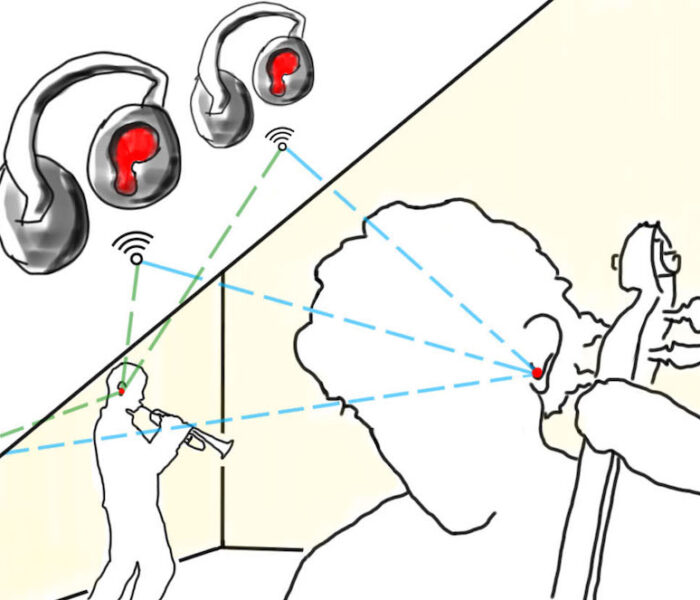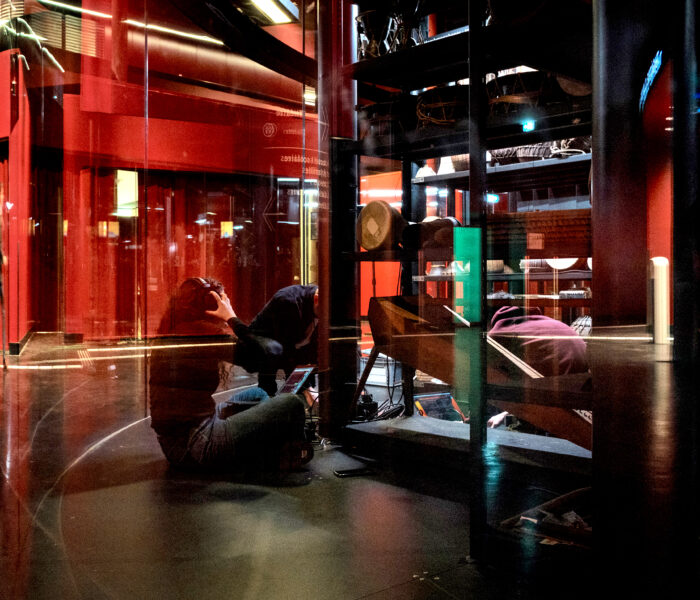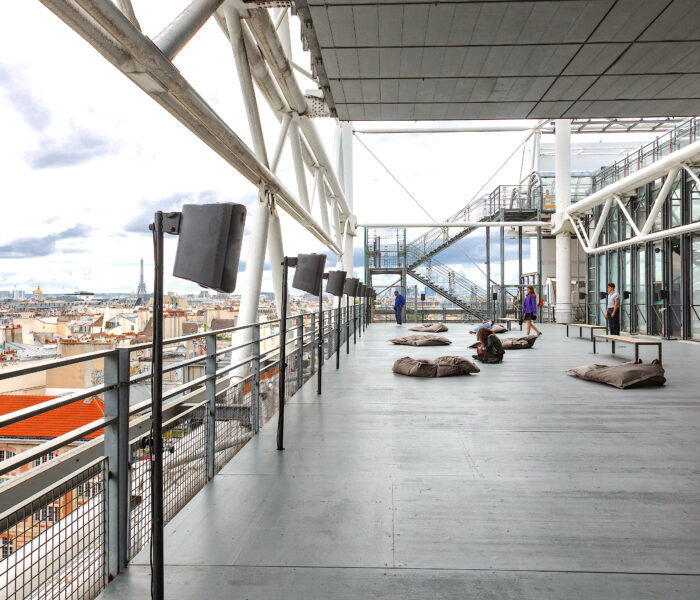Ingénieur du son de formation, Félix Blume façonne le son comme une matière pour créer ses pièces sonores, ses vidéos ou installations. Son travail, centré sur l’écoute, nous invite à transformer notre perception de l’environnement. Le festival Sonic Protest présente Voler le Silence, une première exposition monographique dans l’Ancienne Halle Bouchoule à Montreuil du 19 mars au 2 avril 2023.
Felix, c’est la première fois que vous présentez en France une exposition aussi complète de votre travail. Qu’est-ce qui a orienté le choix de certaines pièces plus que d’autres?
Au début de ma carrière artistique en 2015, Sonic Protest m’avait invité à une collaboration avec Jérôme Fino, puis par la suite, ils ont présenté certains de mes films et projets sonores lors d’évènements ponctuels. Pour construire cette exposition, on est parti de l’envie de présenter l’installation sonore Essaim. Elle se compose de 250 hauts-parleurs suspendus, reproduisant chacun le son d’une abeille en vol (enregistrée de manière individuelle). Ce chœur aérien nous invite à l’écoute de ces petits êtres, de cet infiniment petit, mais aussi à l’écoute de la singularité au sein de la multitude, de l’individu au sein du groupe. Présentée une douzaine de fois depuis sa création, cela sera une première en région parisienne.
Puis d’autres pièces autour de ces thématiques sont venues se greffer autour de celle-ci. Los Grillos del Sueño (Les Grillons du Rêve), projet précédent l’Essaim, a été réalisé de manière collective avec des enfants à La Ligua, petite ville du Chili. Durant quelques semaines, chaque enfant a élevé un couple de grillons dont il a pris soin et qu’il a nourri, nommé, étudié, dessiné, photographié et surtout écouté. Une composition a été constituée à partir du son de ces grillons, qui est accompagnée de la projection d’une courte vidéo réalisée avec des grillons-haut-parleurs, reproduisant chacun le son d’un grillon.
Dans une autre salle, plongée dans l’obscurité, la pièce Cello Suites est présentée pour la première fois. Finalisée il y a quelques semaines à peine, c’est une pièce audiovisuelle composée de plusieurs écrans qui présente des installations sonores éphémères et in-situ dans le désert d’Arizona, à la frontière avec le Mexique. J’ai placé des violoncelles sur d’anciens moulins à vent, pour la plupart en désuétude. Le mât central qui venait jadis actionner une pompe à eau est équipé d’un archer qui vient frotter les cordes du violoncelle. Une seconde vie est ainsi donnée à ces moulins et crée une cartographie sonore et musicale de cette immensité.
Los Grillos del Sueño | Cecrea | Félix Blume from Felix Blume on Vimeo.
Par ailleurs, faisant écho à cette frontière et aux rêves américains, la pièce Fuga donne la parole à ceux qui tentent de la traverser.
Enregistrée en banlieue de Mexico, cette création présente sous la forme d’une fugue, les trajets de ces migrants venus d’Amérique Centrale et du Mexique à la recherche d’une vie meilleure au nord. Réalisée sur une invitation de Phaune Radio, cette pièce a intégré la collection du CNAP– Centre National des Arts Plastiques depuis peu.
Le centre de la ville de Mexico est aussi présent avec d’autres voix, celle des vendeurs ambulants de Coro Informal (Choeur informel). Une série de petites boîtes sonores sont installées pour venir composer et décomposer un paysage sonore des rues animées des quartiers commerçants. Un autre chœur polyphonique se crée.
Enfin, la série de très courtes vidéos Son-Seul / Wildtrack (qui sera aussi diffusée sur Arte dans l’émission Hypernuit le 7 Avril 2023) fait le lien entre ces différents lieux, retraçant une décennie de prise de son avec une pointe d’humour et un côté décalé, burlesque parfois; une invitation à l’écoute des sons qui nous entourent.
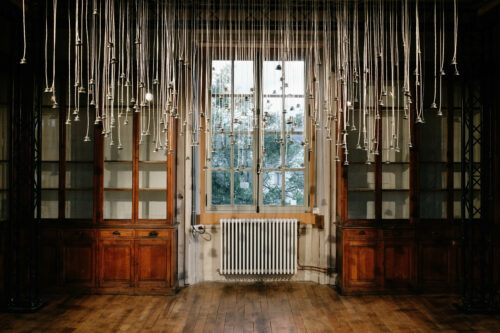
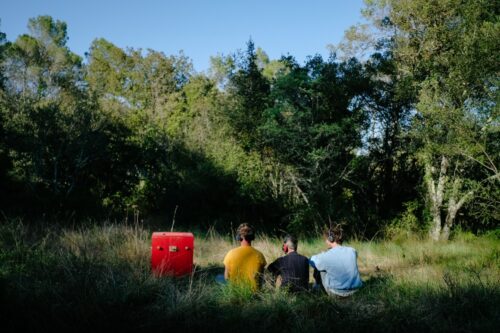
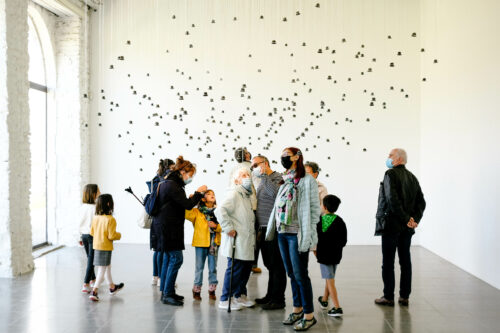
Essaim au festival Maintenant à Rennes et au Domaine de Kerguéhennec
Votre travail, comme on vient de le voir, est multiple. Qu’est-ce qui induit le choix de telle ou telle forme plus spécifiquement ?
Dans ma pratique, j’utilise le son comme une matière que je collecte au travers de la prise de son, ou simplement de l’écoute et que je vais par la suite utiliser comme élément de création. Le processus peut être très différent selon les projets, mais la forme se définit généralement durant la réalisation. Les formes sont souvent multiples, un même projet pouvant aboutir conjointement à une pièce sonore, une installation vidéo ou un film. J’aime garder une certaine liberté et ne pas être tenu par une forme finale de présentation, ni même par une obligation de production. Cette liberté est nécessaire.
Pour le film Curupira, bête des bois que j’ai réalisé dans la forêt Amazonienne (et qui est actuellement présenté au Maif Social Club jusqu’au 22 Juillet 2023) je n’ai su que très tard que cela deviendrait un film. J’ai partagé le quotidien des habitants/es du petit village de Tauary pour y enregistrer des sons, dans l’optique de compléter ma sonothèque personnelle et de les rencontrer. Sur place, à l’écoute des sons de la forêt, j’ai également capté leur présence, leur rapport à cette forêt qui les entoure. Très vite, ils m’ont parlé d’autres créatures qui l’habitent, j’ai alors enregistré ces récits et filmé les personnes qui m’accompagnaient durant les prises de sons quotidiennes. Quelques mois plus tard, en essayant d’assembler ce que j’imaginais être une pièce sonore, les images filmées se sont invitées dans le montage et cela est devenu un film, présenté dans des festivals de cinéma ou comme installation. La forme s’est d’une certaine manière imposée d’elle-même.
Curupira, creature of the woods | Trailer | Félix Blume from Felix Blume on Vimeo.
Le voyage s’est invité dans votre vie depuis longtemps, vous parcourez entre autres des pays comme le Mexique, le Brésil, cela tient-il d’une démarche « anthropologique » ?
La prise de son était au départ principalement lié à mon travail d’ingénieur du son pour le cinéma et le documentaire. En commençant à travailler dès 2015 avec un premier tournage au Mali, je découvre la possibilité de voyager, de découvrir des cultures qui me sont étrangères et de rencontrer l’autre, celui/celle qui m’est inconnu/e. Je viens d’un petit village du Sud de la France, près de Narbonne et le voyage n’était pas une nécessité dans ma jeunesse, ni une envie en soi. Le rythme s’est peu à peu accéléré avec des tournages plus ou moins lointains, des opportunités de voyager vers des endroits dont j’ignorais tout. Sans que ce cela ne soit prémédité, les allers se sont transformés en retours. Depuis lors, une certaine vie nomade s’est installée avec des lieux qui reviennent et d’autres où j’ai pu installer des sortes de bases de vie.
On associe parfois ma démarche à l’anthropologie, mais je n’ai aucune formation d’anthropologue.
Je pense cela dit partager un certain intérêt commun pour l’autre, la rencontre et l’écoute de celui/celle qui est différent.e. Je n’ai cela dit pas de « sujets d’étude » quand je travaille sur un projet et même si la recherche est active chez moi aussi, je ne sais généralement pas ce que je cherche… c’est en explorant que cela se définit.
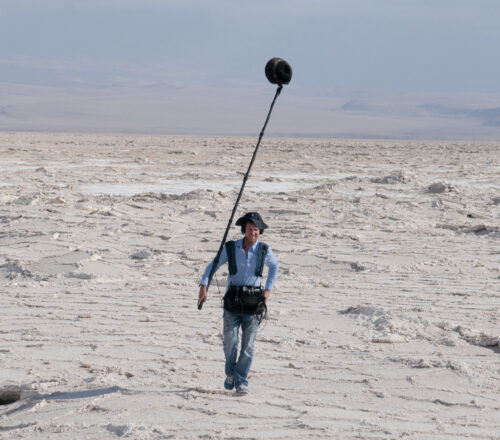

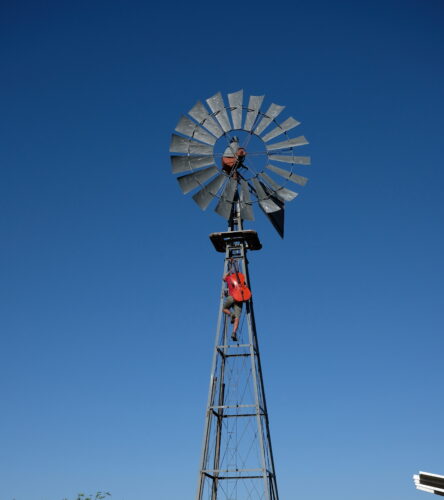
Un axe de votre démarche s’intéresse à la façon dont les gens écoutent. Le collectif est important pour vous; vous développez des projets participatifs lesquels donnent lieu à des œuvres. Pourquoi ce choix?
L’écoute est devenue un axe central dans mon travail. Alors que je pensais que la prise de son était la base de la création, je me suis peu à peu rendu compte que cela se jouait ailleurs, au travers de l’écoute. D’une certaine manière, j’ai réussi à m’affranchir de ma formation d’ingénieur du son. En effet, si les micros et les enregistreurs permettent d’écouter, ils ne sont finalement pas nécessaires. Dans cette rencontre avec l’autre, mon matériel est souvent le prétexte qui justifie ma présence dans un lieu qui m’est souvent inconnu. Et me permet également d’essayer de comprendre comment l’autre écoute. Quand il/elle me recommande l’enregistrement de certains sons de son quotidien, c’est une certaine identité sonore de son territoire qui m’est partagée depuis sa perception. Nous avons tous une écoute singulière, et malgré la présence d’oreilles qui peuvent être similaires, notre cerveau passe son temps à se focaliser sur certains sons et à en éliminer d’autres. C’est cette écoute singulière et subjective que j’essaye de capter, puis de transmettre aux possibles visiteur.euses, spectateurs.trices ou auditeurs.trices.
Lors de ces écoutes partagées et par l’utilisation du son comme médium, les projets participatifs se sont imposés dès le début de ma démarche artistique. Je tente de partager ma connaissance technique des appareils de prise de son pour créer ensemble un projet commun. Les processus sont alors multiples; j’ai réalisé des projets avec des personnes aveugles au Chili, au Mexique ou en Haïti en partant de la spécificité de l’écoute lorsqu’on n’utilise pas la vue. Plusieurs projets se sont fait avec des enfants, avec la grande part d’imaginaire qu’ils/elles peuvent apporter, comme c’est le cas de Rumors from the Sea (Les rumeurs de la mer) réalisé pour la Biennale en Thaïlande, ou Los Grillos del Sueño dont j’ai parlé précédemment. De la même manière que la forme se définit au long du processus, le collectif et la participation de personnes peuvent venir s’imposer dans certains projets, comme cela a pu être le cas pour Lluvias de Mayo (Pluies de mai) réalisé sur la place d’un petit village du Mexique, intégrant peu à peu les habitants/es du village dans le projet sonore.
Dans les films, en règle générale, le son est là pour accompagner l’image. Votre approche est inverse : l’image nous invite à l’écoute. Comment procédez-vous?
Mon travail part du sonore, mais j’ai également un lien avec l’image de par ma formation en école de cinéma et ma carrière de preneur de son pour le documentaire. Pour mieux écouter, on a souvent tendance à s’abstraire du visuel, en fermant les yeux, en proposant des espaces neutres ou libres de toute interférences. Je fais bien sûr des pièces purement sonores, mais j’essaie souvent de jouer avec les éléments visuels qui peuvent devenir des supports à l’écoute.
Quand le son est en lien avec la vidéo, comme c’est le cas dans beaucoup de mes projets, le son vient avant l’image et celle-ci vient renforcer le sonore. C’est assez rare dans la production audiovisuelle. Le travail du son se fait généralement dans un second temps, après celui de l’image, au tournage comme au montage. Dans mon cas, j’inverse les rôles, je commence par monter le son, puis à y glisser peu à peu des images. Au moment du tournage, je sors d’abord mes micros, et puis la caméra dans un second temps, quand je sens que cela devient nécessaire.
Dans mon film Luces del Desierto (Lumières du Désert), projeté le 1er Avril 2023 à 18h30 aux Instants Chavirés, j’ai fait le montage image sur mon logiciel de son. Les possibilités sont évidemment limitées, mais cela permet de mettre bout à bout des vidéos tout en me laissant une grande liberté pour le travail sonore (bien plus complexe que ce que je pourrais faire dans un logiciel de montage image). Je peux ainsi travailler en parallèle les différentes matières du récit, les sons et les images, sans avoir à dissocier les temps de travail comme c’est le cas dans la plupart des films. C’est évidemment possible parce que je fais une grande partie de mes projets seul, sans une personne externe, responsable du montage. Mes derniers projets sonores et visuels sont d’une certaine manière dans la continuité des premières vidéos de Son Seul / Wildtrack où là aussi l’image nous invitait à tendre l’oreille.
Luces del Desierto | Desert Lights | Trailer | Félix Blume from Felix Blume on Vimeo.
Propos recueillis par Anne-Laure Chamboissier
Photos © Faruk Bicici
Photos © Felix Blume
Photos © Juliette Meffre
Photos © Sergio Nahuel
Photos © Gionny Morganti



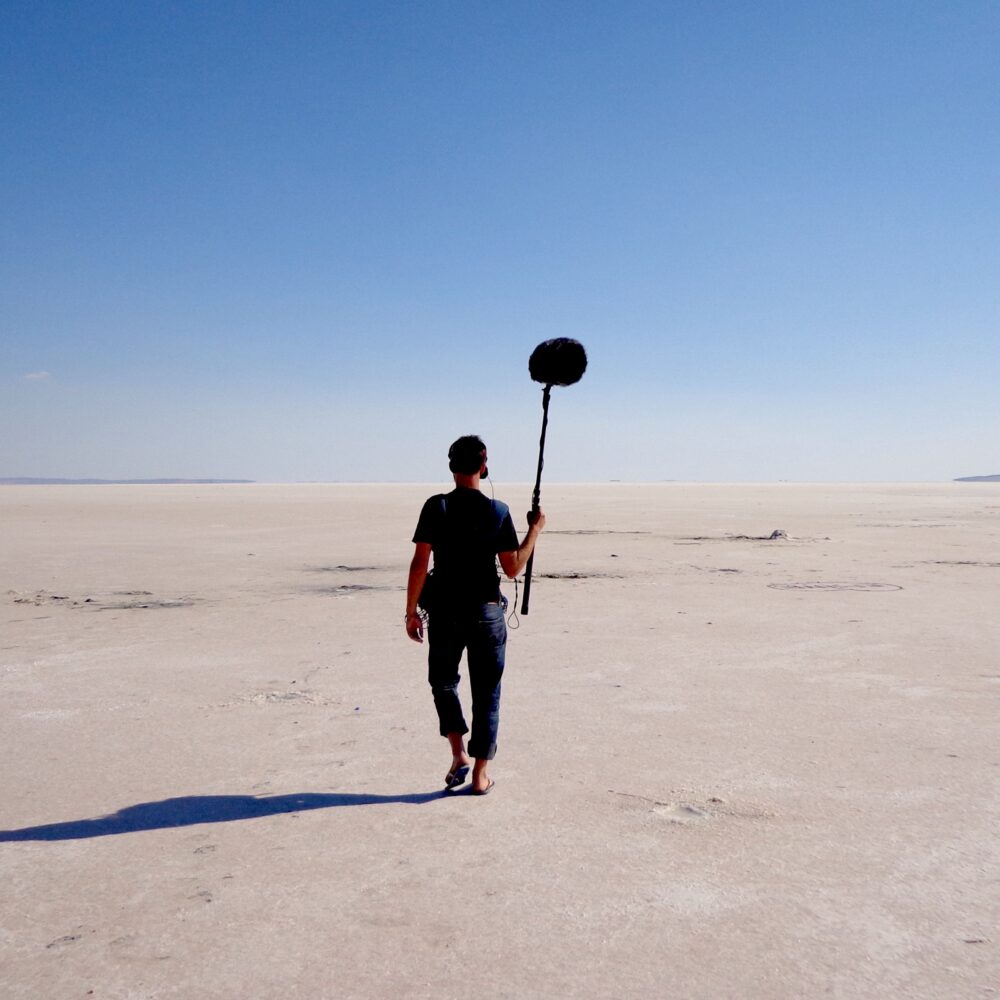)
